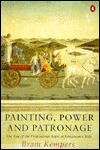

 |

|

The average rating for Painting, power, and patronage based on 2 reviews is 4.5 stars.
Review # 1 was written on 2020-03-11 00:00:00 Lisa Pasqu Lisa PasquA little scattered, but worthwhile resource overall |
Review # 2 was written on 2019-07-07 00:00:00 Natalie Tedford Natalie TedfordEdgar Wind's Pagan Mysteries in the Renaissance, originally published in 1958, is definitely one of the most illuminating books I've encountered on art history. The major problem with Renaissance art is that if you haven't had a classical education most of it is incomprehensible. Since I've not had a classical education that's always put me off a bit. As Wind points though you need more than just a familiarity with classical mythology. You also need at least a basic grounding in the complexities of the Neo-Platonic philosophies with which that age was so obsessed. He also points out that even some of the most familiar paintings of the era are widely misunderstood, paintings like Titian's Sacred and Profane Love and Botticelli's Primavera. The book is absolutely fascinating. He talks at great length about the Three Graces, a popular subject from the classical era right through to the Renaissance. What seems like a simple subject is in fact immensely complex with multiple allegorical meanings. They can represent liberality, the offering, accepting and returning of favours. They can also represent love in a complex Neo-Platonic sense including both physical love and spiritual love and oneness with God. If you look at the many Renaissance examples of this subject there are subtle differences in the positioning and postures of the three figures and these seemingly minor differences conceal important differences in the way various painters (and the philosophers who influenced them) conceived both love and religion. His chapter on Botticelli's Primavera is exhaustive and revealing. He also explains some common but major misconceptions. In Titian's Sacred and Profane Love the temptation is to see the clothed figure as representing sacred love but in fact it's the nude figure who represents the higher spiritual form of love. |
CAN'T FIND WHAT YOU'RE LOOKING FOR? CLICK HERE!!!